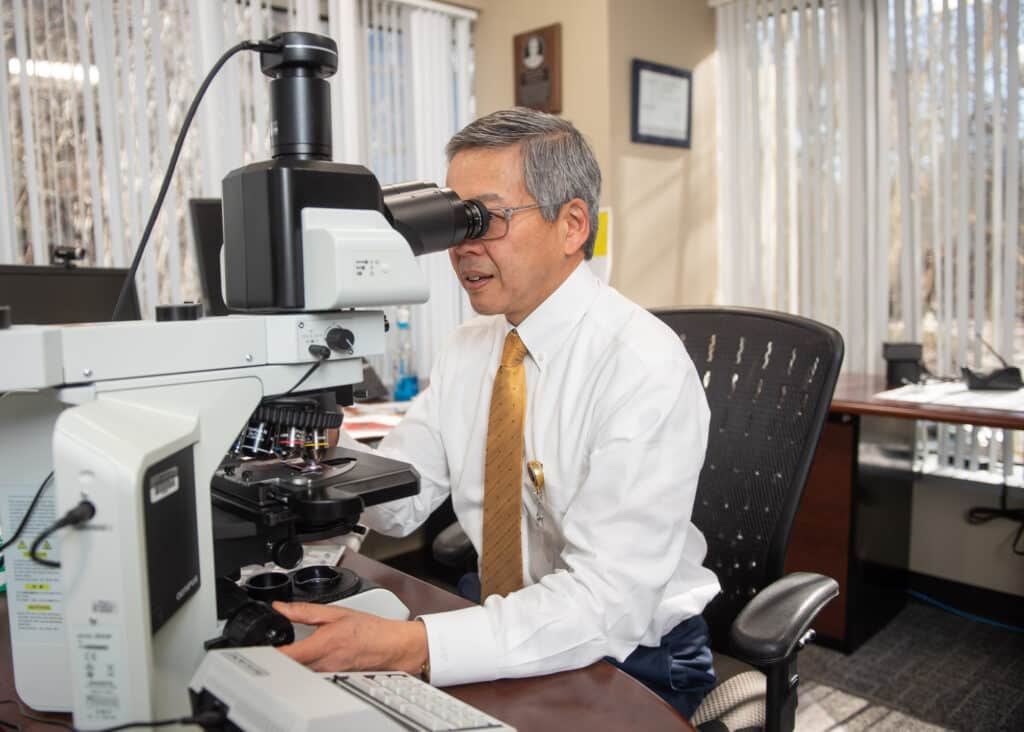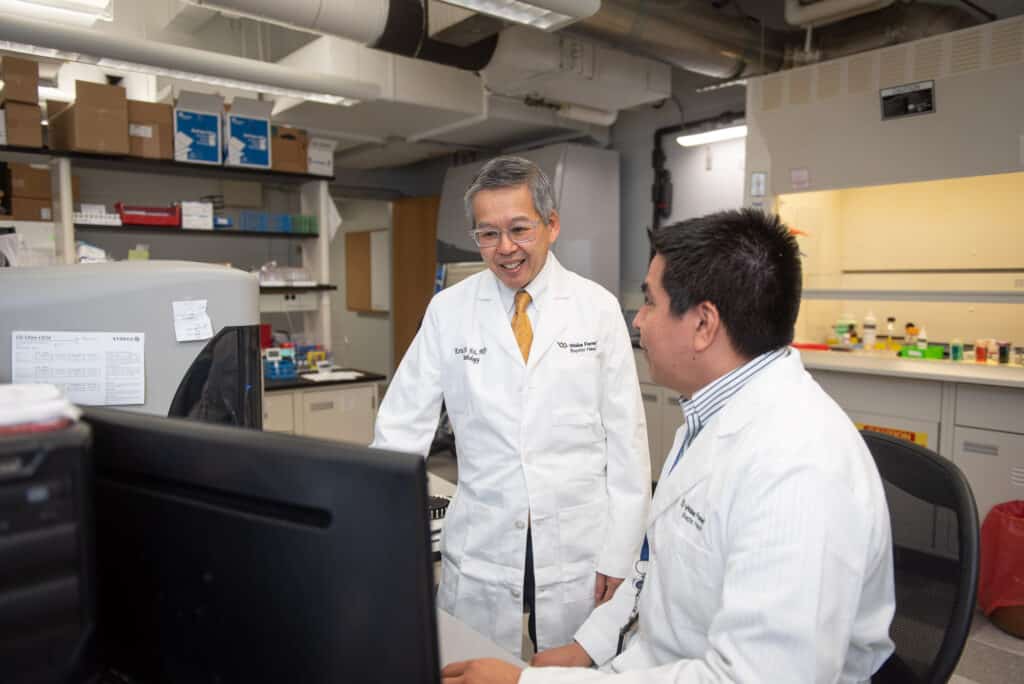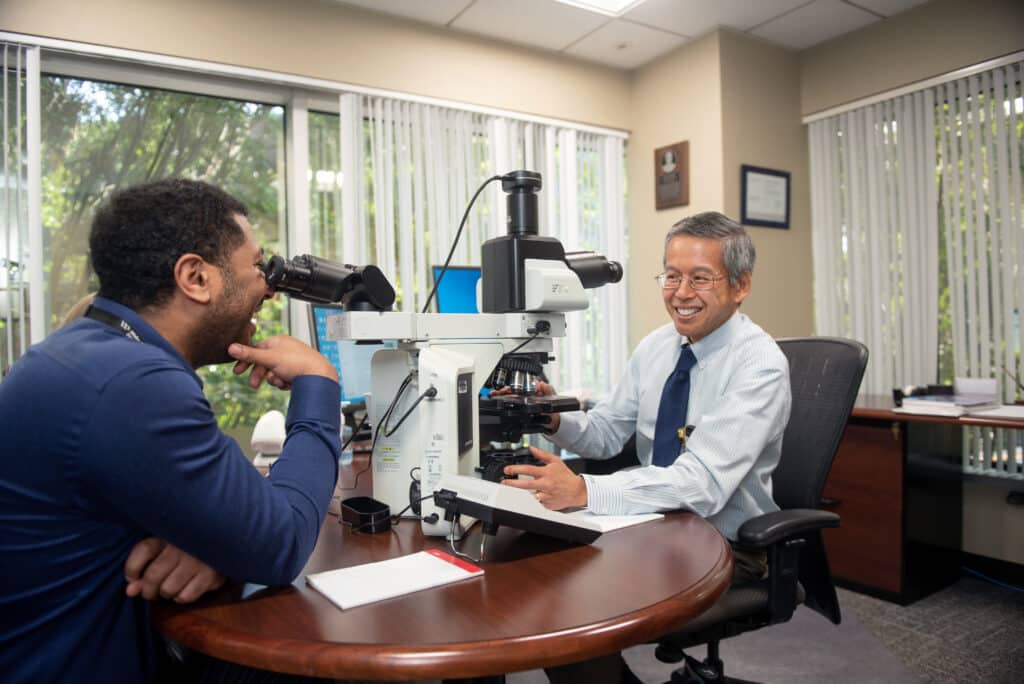A Multi-Layered View to Lymphoma Research

Some people are born to be scientists, and Eric D. Hsi, MD, Department Chair of Pathology at Wake Forest University School of Medicine, is one such person. While he may have always known he wanted to be a scientist, Dr. Hsi’s journey to conducting pivotal lymphoma research was not always as obvious.
Growing up in Michigan, Dr. Hsi was always interested in science. Having a father who was an organic chemist at a pharmaceutical company in Kalamazoo was definitely a contributing factor, Dr. Hsi concedes. After receiving his bachelor’s degree in chemistry from Kalamazoo College, he continued on to the University of Michigan for medical school, residency, and fellowship. Work opportunities brought him to Chicago for a short period, and then he moved to the Cleveland Clinic, where he spent much of his career before making the move to Wake Forest.
The leap from chemistry to pathology doesn’t happen overnight, and for Dr. Hsi, the process was one of self-discovery.
“I was always interested in the science of medicine, so I knew that I’d be a chemistry major, and I always liked working in or around laboratories,” says Dr. Hsi. “I think I sort of backed into a career in pathology as I figured out what I really liked to do.”
After being named a Howard Hughes scholar in medical school, Dr. Hsi took a year off to conduct research at the National Institute of Health (NIH), where, while studying lymphocyte biology cell signaling, he grew interested in the immune system and lymphocyte biology. This experience at the NIH coupled with guidance from mentors during his residency flipped the switch for Dr. Hsi.
“I really enjoyed my hematopathology rotation, and it just clicked that I could be involved in laboratory medicine, clinical work, and academic work in hematopathology. It suddenly became obvious what my career choice should be.”
Prognostic Progress
Dr. Hsi’s interest in lymphoma came at a time when lymphoma classifications were in the process of changing. He soon realized that much of what he was doing in the research lab could be applied to diagnosis and classification.
In his current role as the Department Chair of Pathology at Wake Forest University School of Medicine, Dr. Hsi has a front-row view of the research and the latest technology available to better understand the biology of lymphoma and how that informs diagnosis and disease classifications. In addition to the research he conducts, he works with residents and fellows, conducts laboratory hematology and diagnostic work, and consults with clinicians.

“Conducting biomarker research is both clinical and translational work, all aimed at identifying ways to better diagnose the malignancies, to better classify them, and to better prognosticate or even predict response to therapies in hematologic malignancies,” explains Dr. Hsi.
A biomarker is a biological molecule that is a sign of a normal or abnormal process or of a condition or disease. A biomarker may be used to see how well the body responds to a treatment for a disease or condition. The work that Dr. Hsi is doing is an exciting frontier for the entire lymphoma community. The development of multi-omics, which combines discovery across multiple levels of biology, provides Dr. Hsi and his fellow researchers with a much deeper and unbiased understanding of hematologic malignancies. Previously, a small set of biomarkers that piqued interest would typically lead to questions and further investigation. Now, new technologies allow scientists to broadly survey the landscape and analyze tissues or single cells at the genomic, transcriptomic, epigenetic, and even proteomic levels to look at those features in the malignancies in tissues – and obtain an unbiased look at markers.
“These markers can really help inform treatment decisions by better-risk-stratifying patients,” says Dr. Hsi. “Some predictive biomarkers can help predict how well a patient will respond to different types of treatments, and these biomarkers also play a role in the development of new drugs.”
On the Brink of Breakthroughs
Researchers often share that day-to-day progress can feel slow at times, but reflecting on all that has been accomplished to date, it’s possible to have a greater appreciation for how far we’ve come. That’s particularly true with lymphoma research, according to Dr. Hsi.
“Lymphoma is many diseases, not just one, and each deserves further investigation,” says Dr. Hsi. “We’ve made great progress over the last 10-20 years. When you look back at when I started training to where we are today, it’s night and day. One thing about the lymphoma research community is they’re very open and looking for new investigators to bring in and mentor.”
As a member of LRF’s Scientific Advisory Board (SAB), Dr. Hsi works alongside 44 other lymphoma experts to seek out the most innovative and promising lymphoma research projects for the Foundation to support. He has also been actively involved in LRF’s professional education series, Lymphoma Rounds, and has served as a research mentor through LRF’s Lymphoma Scientific Research Mentoring Program (LSRMP).

As a researcher, Dr. Hsi understands and appreciates the widespread impact LRF is making on the field, from shepherding the next generation of clinicians and scholars through mentoring programs to funding research, supporting lymphoma patients, and bringing people together to focus on finding a cure for lymphoma. According to Dr. Hsi, we are currently on the brink of a wealth of knowledge, insights, and advancements as a result of LRF’s continued focus on lymphoma research.
“It’s an exciting time in science, in general, and for lymphoma, in particular. We’re learning new thing about lymphoma at a faster rate, building upon the research of those who have come before us,” says Dr. Hsi. “The pace of discovery is much faster, along with our general understanding of the biology of these diseases, and in turn, we must continue to train the next generation of clinicians and scholars. Today, some types of lymphoma are now quite curable and many of them quite treatable. One of the most important things patients can do is to arm themselves with the information,
resources, and support that LRF provides.”
Read More Articles from Pulse
Pulse is a publication of the Lymphoma Research Foundation, providing the latest updates on the Foundation and its focus on lymphoma and chronic lymphocytic leukemia (CLL) research, awareness, and education

